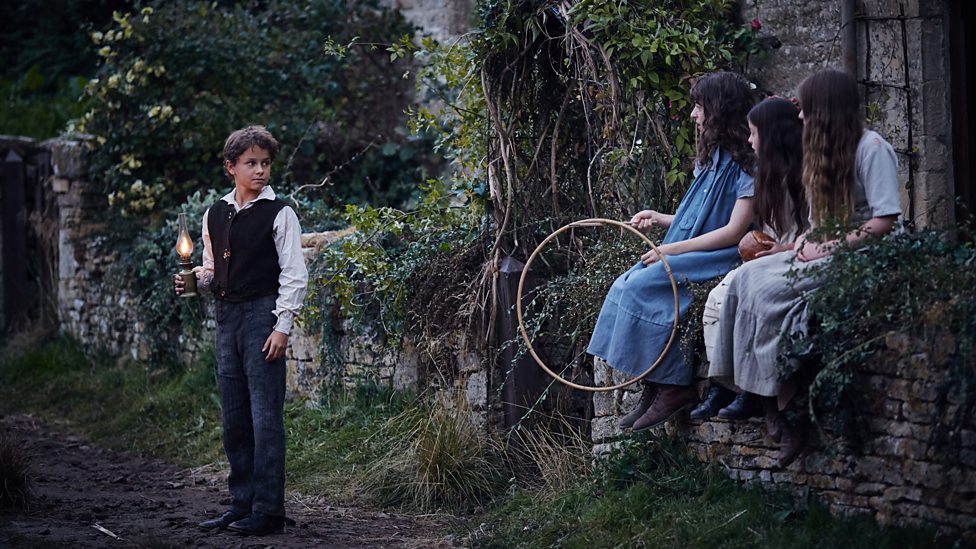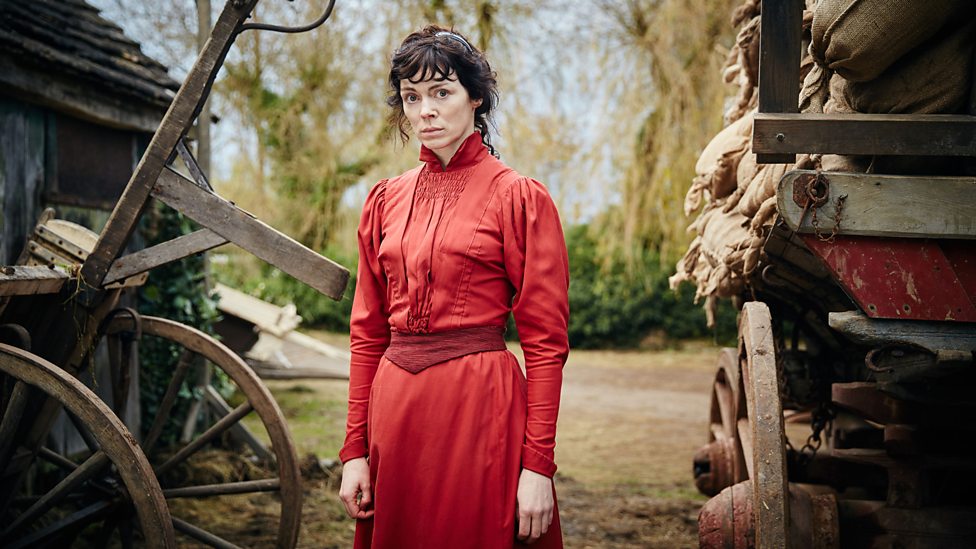Today’s Guest Reviewer is Noelle K. Bowles.

Rural fields, English folklore, an ancient forest – with dark, tangled roots and sudden stony drops – provide the rich and textured setting for The Living and the Dead, a complex tale of grief and horror that weaves its threads from violent personal and national history. Produced by the BBC (2016) and filmed in South Gloucestershire and Horton Court (Cotswolds), the series is worth watching for the cinematography alone. Horton Court – Shepzoy House in the series – may be familiar to those who have seen Wolf Hall and Poldark. Musical arrangements by The Insects provide further atmosphere and are mostly based on traditional folk songs and hymns. We hear interpretations of songs such as A Like Wake Dirge (14th Century) and I am Stretched Upon Your Grave (17th Century), though arguably the most haunting tune, The Reaper’s Ghost (1935), is more recent. The Living and the Dead’s folk-horror genre will raise the hair on your arms without requiring that you sleep with the lights on.
We enter the fictional village of Shepzoy, Somerset on the Summer Solstice of 1894 when psychologist Dr. Nathan Appleby (Colin Morgan) and his photographer wife Charlotte (Charlotte Spencer) return to attend to his dying mother and, upon her death, resolve to leave the hectic pace of London in favor of modernizing the family farm and supporting the villagers who depend on the property for their livelihood. But Nathan was a widower prior to marrying Charlotte; his first, and oddly unmentioned, wife lies in the local graveyard as does his young son, Gabriel, who drowned in the pond near the house. While Gabriel’s ghost haunts Shepzoy in general and his father in particular, his is not the only restless soul. Some of the hauntings are spirits seeking rest, reckoning, revenge, or reconciliation – sometimes in combination. When, in a shocking anachronism and spoiler alert, Nathan hears a jet and observes a contrail above the wheat fields, we realize that just who is haunting whom becomes an important question.

Charlotte Appleby (Charlotte Spencer) and Dr. Nathan Appleby (Colin Morgan) THe iving and the Dead (2016). Source BBC
The series plays with the conflict between the old and new, then and now, in complex ways. The rural village has been slow to join the industrialization of the late nineteenth century, and Nathan and Charlotte Appleby’s arrival and their desire to “revolutionize the way this farm is run” put them at predictable odds with the field hands and their manual labor. The conflict, however, is not merely that of the industrial versus the pastoral or the scientific versus the spiritual; it is also about the debts owed by the living to the dead – and the dead of Shepzoy are especially persistent in their demands for payment. Through their successive and escalating hauntings, the dead expose domestic violence, prejudice, the avarice of acquisition, and the often-unacknowledged link between past abuse and present prosperity. Arguably the most poignant of these hauntings occurs in the second episode when, seeking profit and progress for the farm and the village, Nathan hires railway surveyors to see if Shepzoy might qualify for a branch line. When a surveyor’s blast rains down blood red clay upon Charlie Thatcher (Isaac Andrews), a village boy, he sees the ghosts of other boys whom we learn from an elderly grief-stricken survivor were abandoned to die when the mine collapsed because they were only workhouse orphans, and “it was too expensive to dig them out.” That the mine owner was Nathan’s grandfather forces the Applebys and the viewers to consider the human cost of otherwise vaunted progress.
The central mystery and haunting revolves around Gabriel (Arthur Bateman) whose voice flows off the wax cylinders of the stereograph to haunt Nathan emotionally, whose ghost appears fleetingly to others, and whose crude drawings, reveal a woman with an iPad. Lara, our twenty-first-century ghost, with her iPad and red coat reminiscent of Don’t Look Now (1974) may raise initial worries that the plot will collapse into a dreadful “dream” or “séance” denouement, but the writers are cleverer than that. Though the pay-off is somewhat predictable, the season wraps up nicely, leaving us wanting more. Alas, the BBC has not renewed the series.

Charlie Source: BBC
Pre-Christian symbols and traditions permeate the visual landscape of The Living and the Dead – standing stones, corn dollies, scarecrows that are more Blair Witch Project than not – and the series offers a number of folkloric rewards for the pagan and/or anthropological viewer. When Gwen Pearce (Kerrie Hayes), the housekeeper, ties a bit of rag with Charlotte Appleby’s menstrual blood on the local “fairy tree,” we learn that the ancient customs are alive in function as well as form in Shepzoy. The series is well-researched in this regard, as the thorny hawthorn fairy tree adheres to folkloric traditions and unites it to Victorian flower symbolism representing “hope” while Kate Greenway’s 1884 The Language of Flowers plays a pivotal role in fourth episode. As events of the season draw to their conclusion, Nathan speaks of Gwen’s “hedgewitch cures,” and Gwen herself operates as a positive counterpart to the unfortunate Clarity Winlove, a hedgewitch falsely accused of cursing the crops and drowned by the village’s previous generation.

Played by Colin Morgan Martha played by Fiona O’Shaughnessy Source: BBC
The one real disappointment with The Living and the Dead lies in the treatment of its lone homosexual – the local lesbian “school teacher, spinster,” Martha Enderby, who not only cannot speak the name of her orientation but seems not even to know it: “I loved her the way you love your husband,” she tells Charlotte as she teeters on the brink of sanity. She murdered Alice (Gina Bramhill) because her beloved chose a man instead of her and laughed at Martha’s disclosure of love. Martha rails against the isolation she has been made to feel all her life, and Martha then attempts to strangle Charlotte. Whether her last act of violence is due to insanity as she sees Alice in Charlotte’s place or Alice’s ghost temporarily possessing Charlotte is not clear; it is, however, immaterial (no pun intended) because we realize Martha will brook no refusal from the living or the dead. Spindly, embittered, murderously jealous, likely demented lesbian schoolmarm is stereotypically retrograde in representation. Despite this unfortunate dip into homophobic tropes, on the whole The Living and the Dead is worth viewing.
The Living and Dead -Season One- is available on streaming services including Amazon, YouTube and VuDu. BBC reported that the series was not renewed for a second season.
About Noelle: She teaches literature and writing courses at Kent State University at Trumbull, specializing in nineteenth-century British literature, the fantastic, creative writing, women’s literature, and the basic writing courses everyone loves to hate. When not preparing class materials or grading papers, she spends her time kissing her Frenchie, complaining about cat hair, cooking Indian cuisine, and shaping clay into ceramic monsters, oh…and reviewing television and film.
The Wild Hunt is not responsible for links to external content.
To join a conversation on this post:
Visit our The Wild Hunt subreddit! Point your favorite browser to https://www.reddit.com/r/The_Wild_Hunt_News/, then click “JOIN”. Make sure to click the bell, too, to be notified of new articles posted to our subreddit.